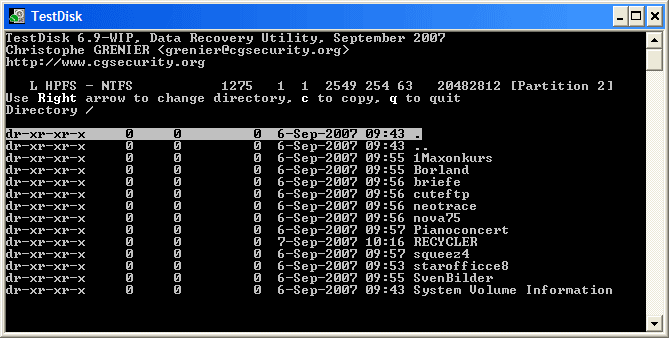

- #Testdisk none partition how to
- #Testdisk none partition update
- #Testdisk none partition upgrade
- #Testdisk none partition zip
- #Testdisk none partition windows
Testdisk should be able to access a ext4 partition Actual behavior

#Testdisk none partition update
SetupĭSM version: 6.2.2-24922 Update 4 (package compiled as 6.1) Expected behavior Requesting that e2fsprogs be added to the build or some advice on compiling it. I have tried compiling the package with some settings added but have not been successful. This was noticed when accessing a ext4 partition via testdisk on Windows/Ubuntu but gives a compilation message when accessing via DSM.

Step 2: Wait until the analyzing process is completed. In the new window, directly choose Quick Search to continue. Step 1: Launch TestDisk, click Create, select the disk where partitions are lost, choose the partition table type, and then select Analyse. instead of Structure: Ok.Testdisk appears to not be compiled with e2fsprogs. Here is the guide on how TestDisk recovers a partition. It seems that making the linux partition logical is the only option, as otherwise I get Structure: Bad. I need to have the win10 partition (2nd NTFS partition) to be bootable and the linux partition (1st linux partitoin) to be bootable. I am suggesting that the partitioning scheme in testdisk could look like this below. Sector size (logical/physical): 512B/4096B dev/sdb1 * 62 3909347 1954643 c W95 FAT32 (LBA)Īnd the output of command sudo parted /dev/sda unit s print is: Model: ATA Hitachi HTS54757 (scsi) I/O size (minimum/optimal): 512 bytes / 512 bytes Sector size (logical/physical): 512 bytes / 512 bytes Partition 6 does not start on physical sector boundary.Ħ2 heads, 62 sectors/track, 1017 cylinders, total 3911680 sectors Partition 3 does not start on physical sector boundary. I/O size (minimum/optimal): 4096 bytes / 4096 bytes Sector size (logical/physical): 512 bytes / 4096 bytes The output of sudo fdisk -l during the usb recovery session is: Disk /dev/sda: 750.2 GB, 750156374016 bytesĢ55 heads, 63 sectors/track, 91201 cylinders, total 1465149168 sectors If anyone can just inform me which were my primary, logical and extended partitions it would help. I need to get them back to the way they were and feel way over my head with the options available. When I run TestDisk the list of partitions look like this after the quicksearch.
#Testdisk none partition how to
I am completely confused how to do this correctly. I tried to run TestDisk to regain the partitions that were lost.
#Testdisk none partition windows
Setting both bcdedit /set path \EFI\ubuntu\grub圆4.efi in windows commandline with admin privilege didn't help. I tried the advice on this page - boot-repair doesn't work. try using following procedure : make partition with fdisk. some cases you can not find your partition anymore.
#Testdisk none partition upgrade
Upon restart the windows 10 upgrade continued and finished as expected, except the boot menu doesn't appear with the option to boot into Ubuntu. Also you can use files in proc directory cat /proc/partitions This will show all partition that Kernel will care of and command partprobe can regenerate this file. During the boot-usb session I noticed that the linux partitions are marked as unknown.
#Testdisk none partition zip
Dcompressez l’archive zip puis excutez le fichier testdiskwin.exe. Pour restaurer une partition de disque perdue, non accessible ou en RAW avec TestDisk, suivez ces instructions : Tlchargez l’archive de TestDisk. etc., so used the second highest voted method which requires booting from a rescue-usb and running boot-repair. Restaurer une partition de disque perdue, non accessible ou en RAW. I couldn't make the highest voted method work due to being unable to find the bootable partition using ls (hd0,msdos6)/ etc. I found some help with this at this page - grub-rescue. It did not work as suggested and part way through the upgrade I was faced with a grub rescue prompt. I have tried to upgrade my windows from 7 sp 1 to 10 using the MediaCreationTool.exe as suggest in this page - howtogeek.


 0 kommentar(er)
0 kommentar(er)
